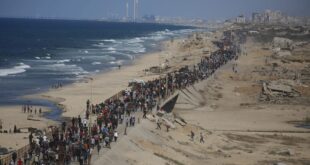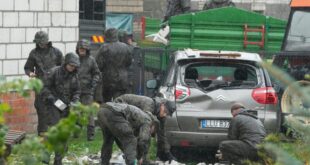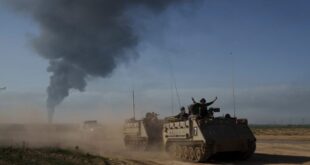There are reports of panic buying of iodine drops in Severodvinsk. Emergency officials reported a spike in background radiation. The White Sea bay where both the shipbuilding port and the regional capital Arkhangelsk are located has been ordered closed for swimming and fishing, due to the presence of toxic rocket fuel.
A month after a fire aboard a secretive military submarine killed 14 people and prompted criticism of the Russian Defense Ministry, a new fatal incident involving military forces in Russia’s far north has raised new criticism of how authorities handle deadly, and potentially embarrassing, information.
The explosion, reported August 8, occurred in the town of Nyonoksa, a Dvina Bay port not far from the shipbuilding town of Severodvinsk, at a naval site that has been used for decades to test naval missiles, including intercontinental ballistic missiles (ICBMs).
In its initial statement on the incident, the Defense Ministry said two people were killed and six injured in the blast and the fire that resulted. The ministry said that liquid rocket fuel was the cause of the blast, but that “no harmful chemicals were released into the atmosphere.”
In the hours that followed, however, city emergency officials in Severodvinsk reported a spike in radiation levels.
The levels were 20 times higher than normal, according to Greenpeace, which prompted the environmental group to call on federal authorities to identify exactly what kind of radiation had been released and if it was any danger to nearby residents.
Emergency officials, meanwhile, said that radiation levels posed no risk to people nearby, and did not exceed annual norms for humans.
That hasn’t assuaged the concerns of residents of Severodvinsk. The Arkhangelsk regional news site 29.ru said that nearly all the pharmacies in the city have been emptied of iodine drops, which are used to protect the thyroid gland from certain types of radiation.
Contacted by telephone by RFE/RL, one pharmacy in Severodvinsk reported being sold out of iodine as of August 8. A second said most of its supplies had been bought up. Neither of the employees who answered the phones would give their names.
Ban On Swimming And Fishing
Citing unnamed officials at the Arkhangelsk airport, 29.ru also reported that three of those injured in the explosion had been sent in an emergency flight to Moscow for treatment, and those accompanying them were wearing hazardous material protective suits.
On August 9, meanwhile, the newspaper Kommersant reported that military officials had ordered a month-long ban on swimming and fishing in the entire Dvina Bay, which flows into the White Sea, after detecting the presence of a highly toxic rocket fuel known as heptyl. The fuel has been used in Russian rockets for years; Kazakh environmentalists have long complained about heptyl-fueled rockets being launched from the Baikonur launch facility poisoning the Kazakh steppe.
Norway’s official nuclear safety agency reported August 9 that its sensors had not reported any increase in radiation levels since the previous day, and it had received no official notification from Russia about any potential incident.
Severodvinsk, which has nearly 180,000 inhabitants, itself is the site of two major naval shipyards that build and repair nuclear-powered submarines, and other ships. Environmental groups have for years warned of increased radiation levels in nearby waters.
If the incident was indeed caused by a rocket explosion or crash, the most important question, said Andrei Zolotkov, a Murmansk-based researcher with the environmental monitoring group Bellona, is where it occurred: on land or in the water. That will determine how much contamination is released and where, he said.
“It’s a bad thing either way,” Zolotkov told RFE/RL.
Russian news agencies said that three of the injured were in critical condition. What was potentially more concerning, Zolotkov said, were the reports about emergency workers wearing radiation suits as they accompanied some of the injured being transported to Moscow hospitals.
That would be an indication of radioactive contamination, something that the Nyonoksa test site isn’t known for, he said: possibly a low-level nuclear device or even a nuclear-powered rocket engine.
“This worries me more than anything else,” he said.
Distrust Of Authorities
The explosion is the second mishap to occur at the Nyonoksa test site in recent years. In 2015, a test of a cruise missile went awry, sending the weapons flying into an apartment building. No casualties were reported, nor was there any reported radiation or other contamination.
Last month, another incident involving Russia’s Northern Fleet also drew criticism from Russians upset by a lack of information from authorities. And earlier this week, a series of massive explosions destroyed an arms cache in Siberia, sending blast waves and plumes of black smoke into the atmosphere, and devastating nearby settlements.
A secretive surveillance submarine known informally as the Losharik suffered a catastrophic accident on July 2 while conducting tests in the Barents Sea. In all, 14 crew members were killed. Officials have released scant details about the sub, which is based at the Kola Peninsula port of Severomorsk, and what exactly occurred during the fire.
During funerals for the personnel who died, one Russian naval officer made comments that suggested the incident posed a far greater danger than the Defense Ministry had indicated, saying that the crew of the vessel — which authorities eventually revealed had a nuclear reactor on board — had “averted a planetary-scale catastrophe.”
Zolotkov said that the reports of people panic buying iodine in Severodvinsk was symptomatic of the distrust that Russian civilians have for the authorities and for public statements after incidents like this.
The regional emergency service statement about the spike in background radiation had been published August 8 on the official website of the Severodvinsk city administration. By August 9, however, the statement was no longer available on the site. Asked by the news site 29.ru about the missing statement, a city civil defense official cited an unspecified technical problem; another city official said they were working on the issue.
He pointed to the Kursk disaster in August 2000, when the Kremlin and military officials concealed the details of a sunken sub, some of whose crew survived the explosions that crippled the vessel.
He also pointed to the news concerning a mysterious radioactive cloud that drifted over Europe in 2017. European researchers recently concluded that a notorious nuclear processing facility in the southern Ural Mountains, known as Mayak, was the likely source of the release.
The repeated Russian denials, which continued even after the release of the peer-reviewed publication, further undermine trust in Russian official statements, Zolotkov said.
“The populace does not trust government agencies when they say, ‘Don’t worry, everything is OK’,” he said. “And then we’ll have another incident, and we’ll get the same misinformation from the authorities again. That just shows the population doesn’t believe what the officials are saying.”
 Eurasia Press & News
Eurasia Press & News



